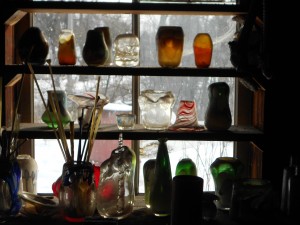A twist of colored glass, a North Country river, a hard, fascinating life
 It’s strange where life takes you. Matt Foley, who I profiled today, runs a couple of hydro-power dams in the Adirondacks, in Wadhams in Essex County and St. Regis Falls in Franklin County.
It’s strange where life takes you. Matt Foley, who I profiled today, runs a couple of hydro-power dams in the Adirondacks, in Wadhams in Essex County and St. Regis Falls in Franklin County.
He got his start as an artisanal glass blower back in the 1970s. When the energy crisis hit, he set out across the North Country looking for a cheap way to power his art.
That jumping off point led to a life of wrestling with North Country rivers and tangling with the politics of energy production in the US.
He prowled the backcountry, salvaging parts from abandoned hydro projects in Speculator, Saranac Inn, and the old Lake Placid Club.
His dams, which feed electricity to about 600 North Country homes, are part of a long history, a tradition where local hydro powered industries and whole communities. (Foley’s Wadhams plant powers most of the homes in Westport.)
His two dams survived last year’s spring floods and tropical storm Irene and Foley is clearly weary, as worn out and frustrated as many of the farmers and loggers who’ve struggled to make a go of it in our hardscrabble region.
Not an easy life, but a fascinating one, carved out of an American tradition of ingenuity and hard-work.
“When I got here I had a BA in psychology and I was the child of an office worker,” Foley told me.
“I was completely ignorant. What it comes down to is if you don’t know how to do something, just start. Make a start somewhere and if you’re doing it right, you’ll find that out. And if you’re doing it wrong, you’ll find that out, too.”
When I was visiting his power plant in Wadhams, I noticed these old pieces sitting on a shelf in a window. Foley, who’s 63 now, says he hasn’t blown glass for three decades.
But it all began with those shapes of melted glass.
Tags: adirondacks, arts, energy








Brian,
I have spent some time on the St. Regis river above the dam where one of these plants is located. It seems to me that the “natural” level of this river is much higher now than it was in the past. I say this because it seems like many trees and some structures that were built before they started making power there are now under water even at low water periods. For example Long Pond above this dam has many large trees under water and dying. These are tress that were obviously growing for many decades on what was higher ground. This is a pond right next to the river that must have its levels affected by the river. Do you know if the water levels are different now that they were when the dams were originally built for logging? I put “natural” above in quotes since obviously it isn’t the natural level I am talking about but I guess the historic levels since the turn of the last century.
I think that is pretty neat.